Study on the Algorithm of Three-Dimensional Surface Residual Material Height of Nano-ZrO2 Ceramics under Ultra-Precision Grinding
Abstract
:1. Introduction
2. The New Method for Calculating the Height of the Surface Residual Material of Nano-ZrO2
2.1. Probabilistic Analysis of the Grinding Process of Nano-ZrO2 Ceramics
2.2. The New Method for Calculating the Height of Residual Materials on the Grinding Surface of Nano-ZrO2
3. Application of the New Calculating Method in the Prediction of Three-Dimensional Roughness
3.1. Establishment of Three-Dimensional Roughness Evaluation Datum Plane
3.2. The Arithmetic Square Root Deviation of the Machined Surface
3.3. The Root Mean Square Deviation of the Machined Surface
4. Experimental Verification
4.1. Experimental Scheme
4.2. Experimental Results and Discussion
5. Conclusions
- In this study, a new method for calculating the height of surface residual materials of Nano-ZrO2 ceramic in ultra-precision grinding was proposed, which can obtain the height of surface residual materials that conform to the characteristics of three-dimensional roughness sampling and has more accurate results. It is of great significance for the development of the three-dimensional roughness prediction model for ultra-precision grinding;
- The numerical value and change trend of and under different grinding conditions measured in the experiment are consistent with the calculation results of the prediction model. The Nano-ZrO2 ceramic three-dimensional roughness prediction model developed by the new method for calculating the height of surface residual materials of Nano-ZrO2 ceramic in ultra-precision grinding has better accuracy and reliability;
- Simulation and experimental results show that grinding with lower feed rate, lower grinding depth, and higher grinding wheel linear speed can reduce the cutting depth of single abrasive particle and micro-crush damage of the machined surface, and the accumulation of residual material on the machined surface can be weakened, thus making the height of the residual material on the machined surface descent.
Author Contributions
Funding
Conflicts of Interest
References
- Gong, Y.; Wang, B.; Wang, W. The simulation of grinding wheels and ground surface roughness based on virtual reality technology. J. Mater. Process. Technol. 2002, 129, 123–126. [Google Scholar] [CrossRef]
- Zhou, X.; Xi, F. Modeling and predicting surface roughness of the grinding process. Int. J. Mach. Tools Manuf. 2002, 42, 969–977. [Google Scholar] [CrossRef]
- Hou, Z.B.; Komanduri, R. On the mechanics of the grinding process—Part I. Stochastic nature of the grinding process. Int. J. Mach. Tools Manuf. 2003, 43, 1579–1593. [Google Scholar] [CrossRef]
- Agarwal, S.; Rao, P.V. Modeling and prediction of surface roughness in ceramic grinding. Int. J. Mach. Tools Manuf. 2010, 50, 1065–1076. [Google Scholar] [CrossRef]
- Xiao, X.Z.; Li, G.; Li, Z.H. Prediction of the surface roughness in ultrasonic vibration-assisted grinding of dental zirconia ceramics based on a single-diamond grit model. Micromachines 2021, 12, 543. [Google Scholar] [CrossRef] [PubMed]
- He, B.F.; Wei, C.E.; Liu, B.X.; Ding, S.Y.; Shi, Z.Y. Three-dimensional surface roughness characterization and application. Opt. Precis. Eng. 2018, 26, 1994–2011. [Google Scholar]
- Li, C.G.; Dong, S. The current situation and development of surface roughness. Aviat. Precis. Manuf. Technol. 1999, 5, 1–4. [Google Scholar]
- Zhou, W.; Tang, J.; Chen, H.; Zhu, C.; Shao, W. A comprehensive investigation of plowing and grain-workpiece micro interactions on 3D ground surface topography. Int. J. Mech. Sci. 2018, 144, 639–653. [Google Scholar] [CrossRef]
- Chen, H.; Tang, J. A model for prediction of surface roughness in ultrasonic-assisted grinding. Int. J. Adv. Manuf. Technol. 2015, 77, 643–651. [Google Scholar] [CrossRef]
- Setti, D.; Ghosh, S.; Rao, P.V. A method for prediction of active grits count in surface grinding. Wear 2017, 382–383, 71–77. [Google Scholar] [CrossRef]
- Younis, M.; Alawi, H. Probabilistic Analysis of the Surface Grinding Process. Trans. Can. Soc. Mech. Eng. 1984, 8, 208–213. [Google Scholar] [CrossRef]
- Agarwal, S.; Rao, P.V. A probabilistic approach to predict surface roughness in ceramic grinding. Int. J. Mach. Tools Manuf. 2005, 45, 609–616. [Google Scholar] [CrossRef]
- Jiang, J.L.; Ge, P.Q.; Hong, J. Study on micro-interacting mechanism modeling in grinding process and ground surface roughness prediction. Int. J. Adv. Manuf. Technol. 2013, 67, 1035–1052. [Google Scholar] [CrossRef]
- Company, N. Standard Stock and Specifications Manual; Municode library: Tallahassee, FL, USA, 1978. [Google Scholar]
- Zhang, Z.; Cui, H.; Ding, H.; Guo, L. The reference plane by wavelets for 3D roughness evaluation of micro wire electrical discharge machining (MWEDM). J. Harbin Eng. Univ. 2011, 32, 1185–1189. [Google Scholar]
- Qiao, G.C. Research on Machined Surface Integrity in Ultrasonic Vibration Mill-Grinding of Silicon Nitride Ceramics; Doctor, Harbin Institute of Technology: Harbin, China, 2013. [Google Scholar]
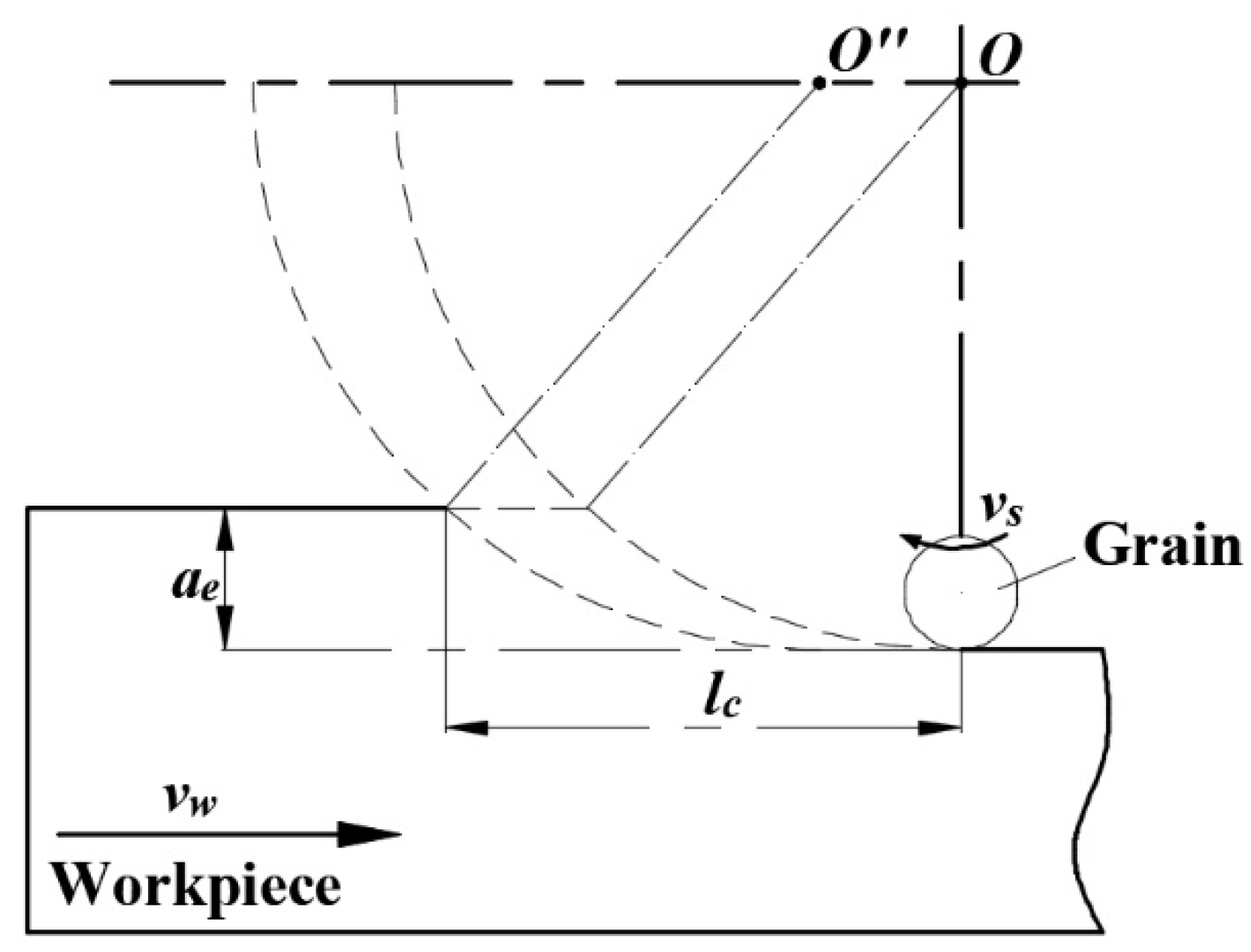


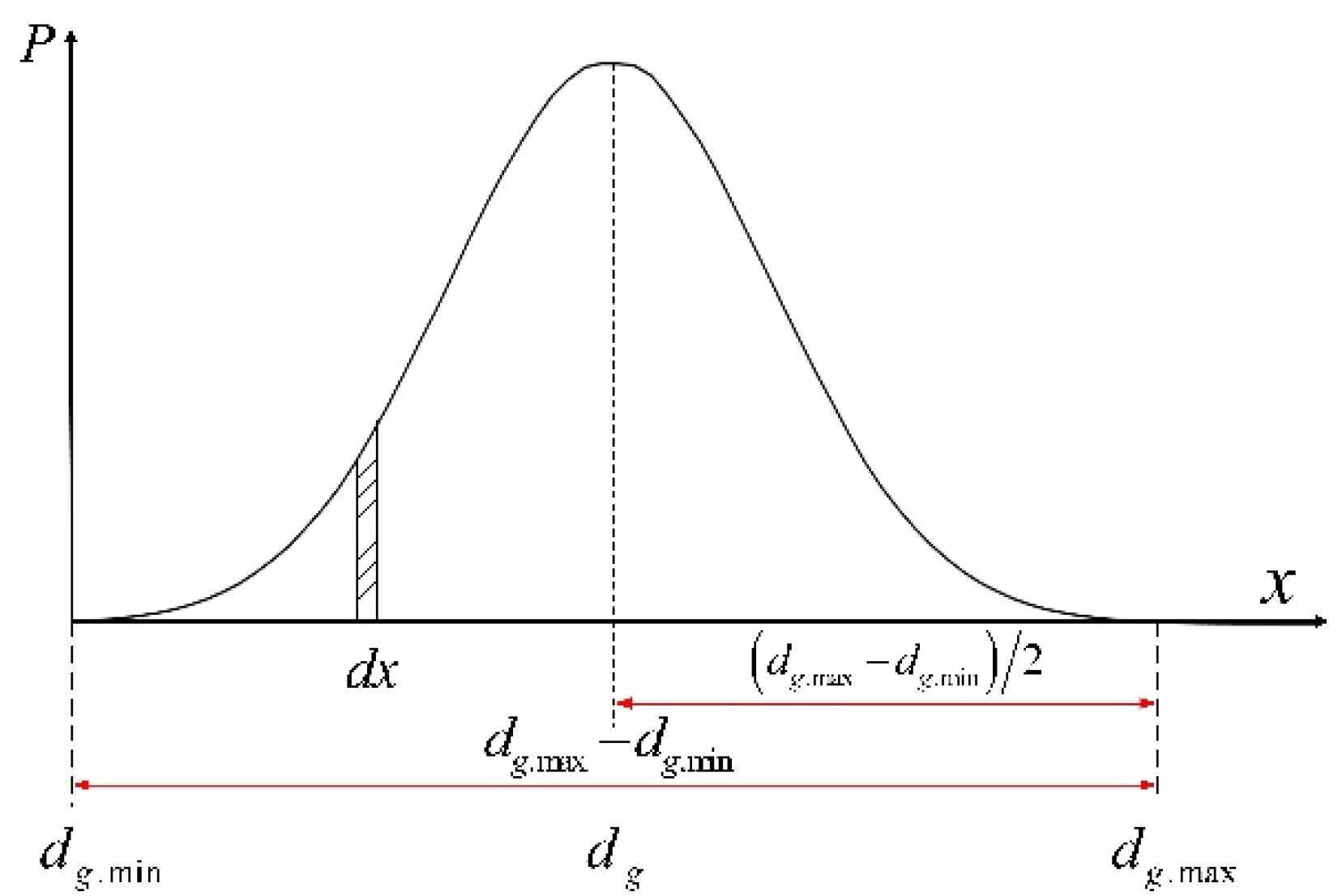

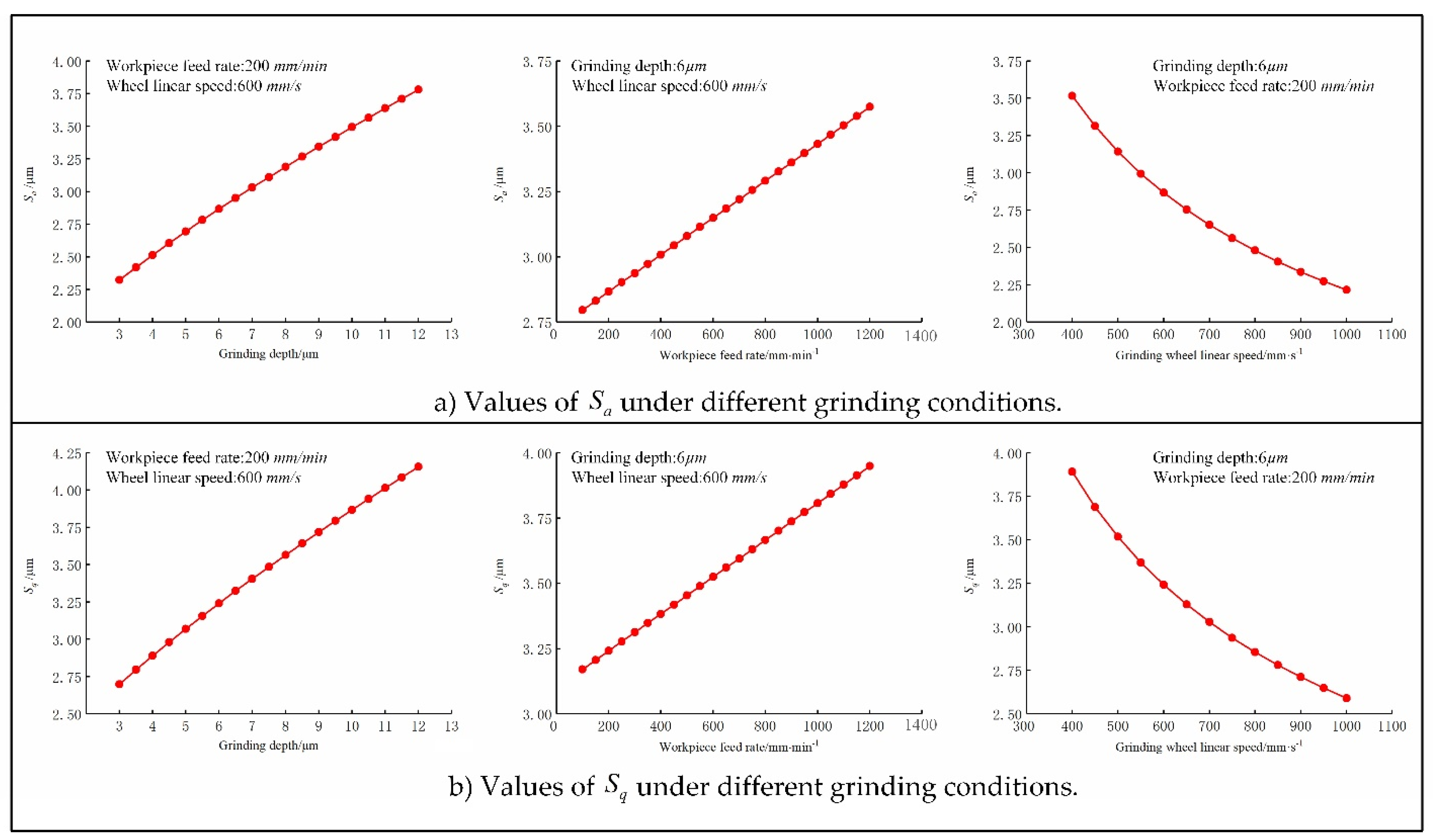
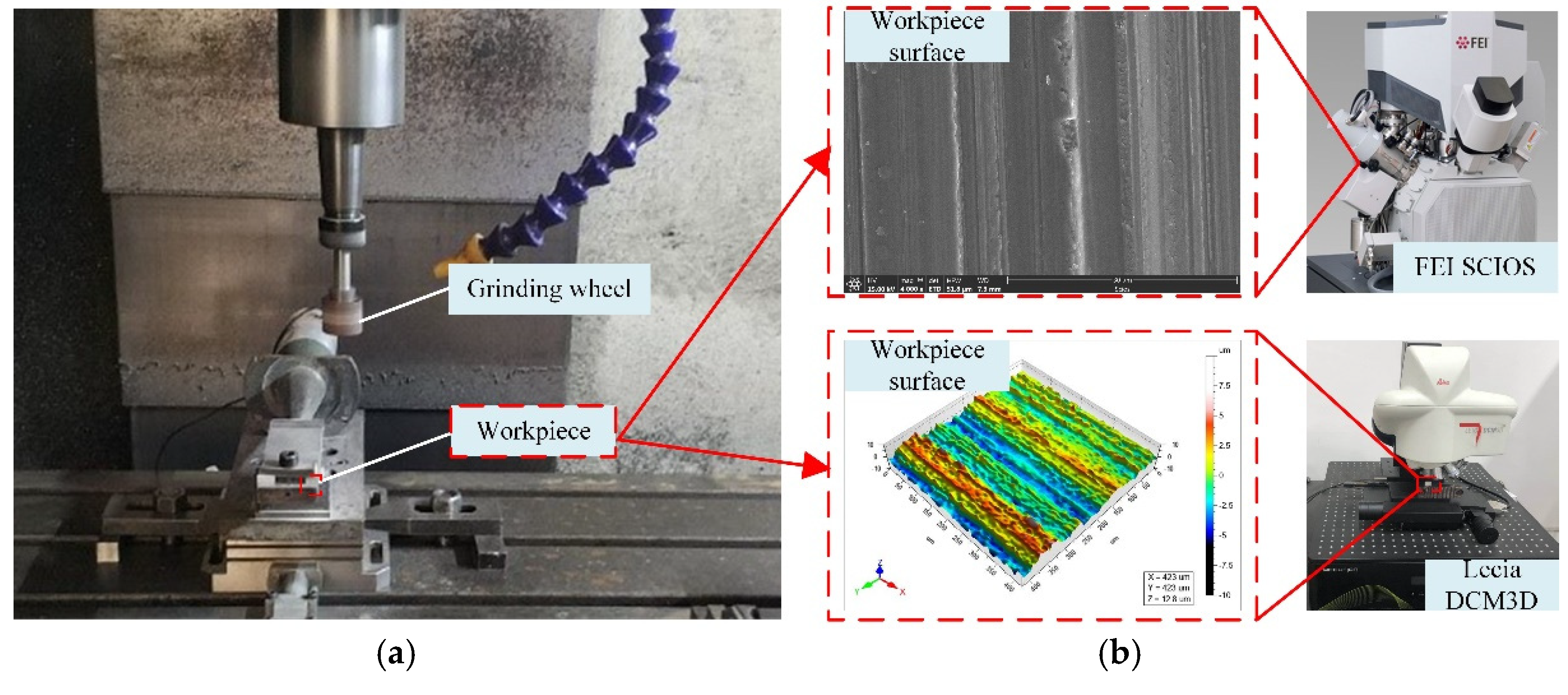
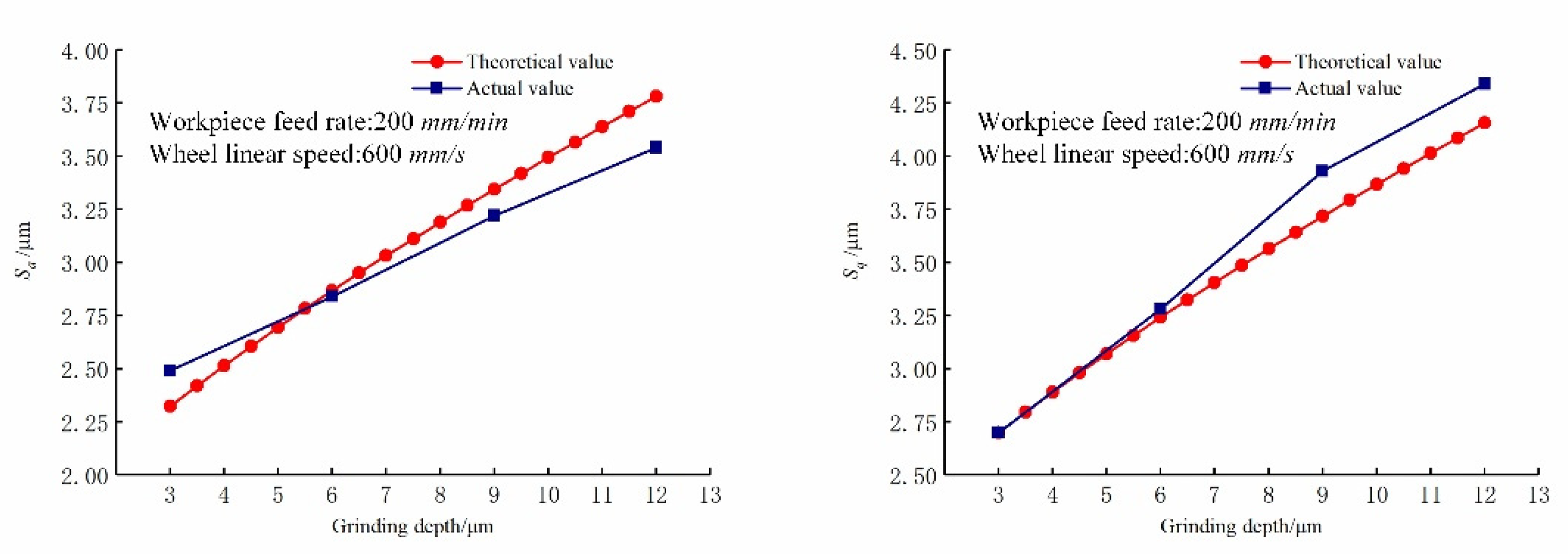
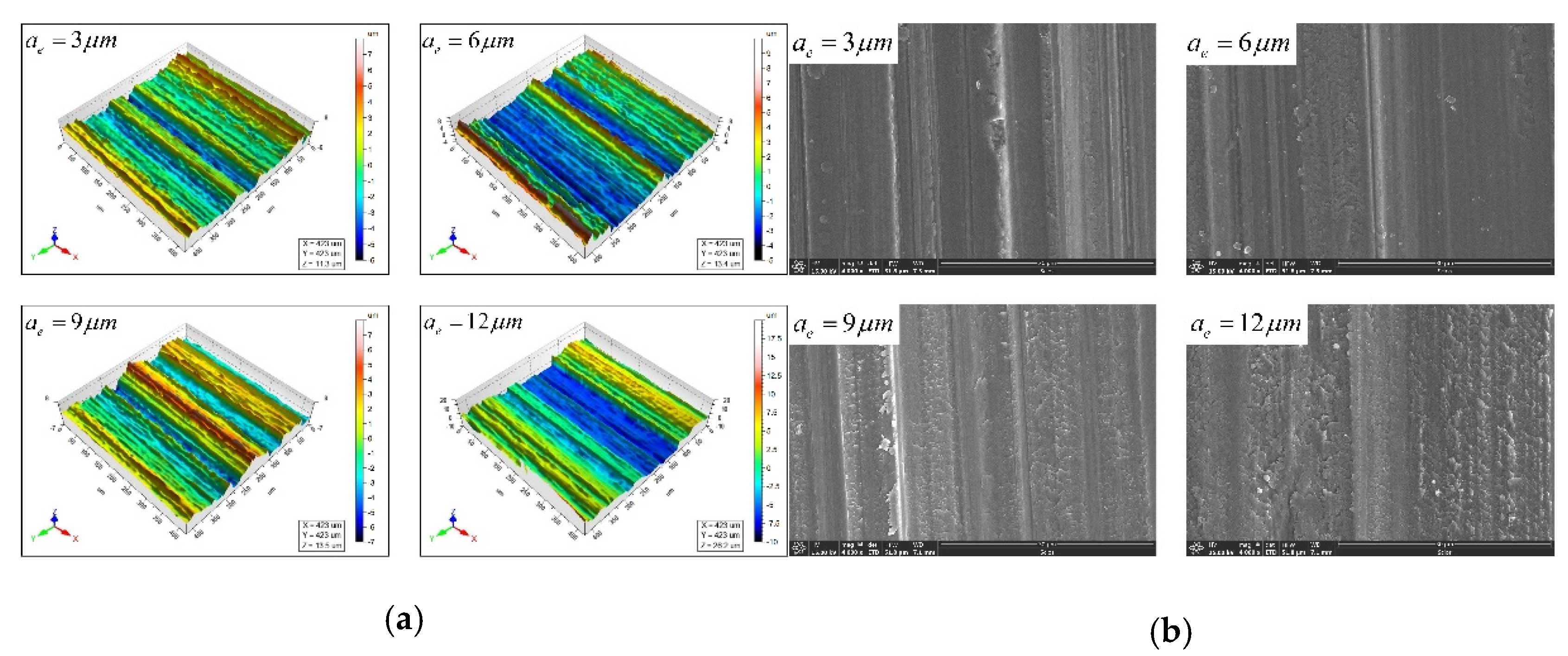



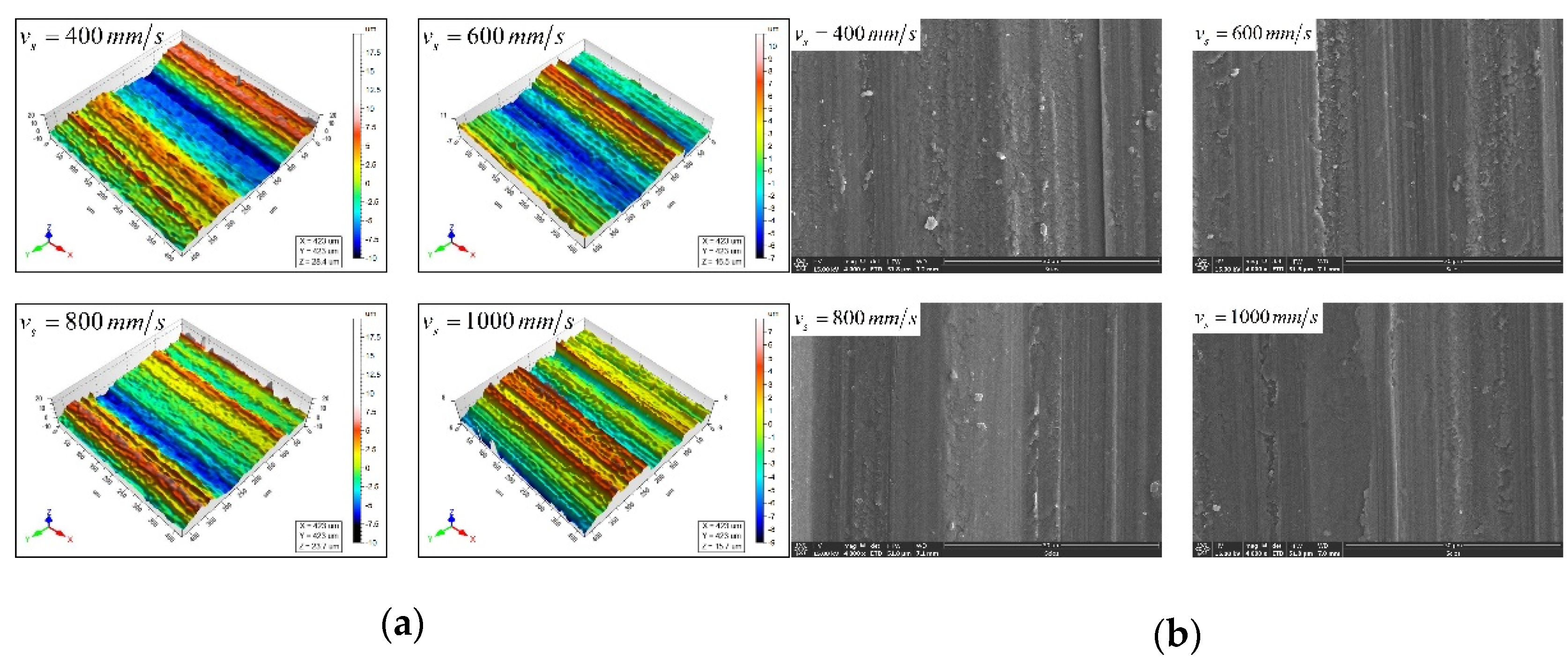
| Exp. Number | Grinding Depth ae/μm | Workpiece Feed Rate vw/mm·min−1 | Grinding Wheel Linear Speed vs/mm·s−1 |
|---|---|---|---|
| 1 | 3/6/9/12 | 200 | 600 |
| 2 | 6 | 100/400/800/1200 | 600 |
| 3 | 6 | 200 | 400/600/800/1000 |
| Condition | Feature |
|---|---|
| Grinding method | Dry grinding |
| Workpiece material | Nano-ZrO2 ceramic |
| Size of workpiece | 15 × 10 × 5 mm |
| Grinding wheel | Resin-based diamond grinding wheel, 150#, 150% |
| Diameter of wheel | D = 25 mm |
| Item | Parameters |
|---|---|
| Density (g/cm3) | 5.5–6.05 |
| Poisson ratio | 0.3 |
| Elastic modulus (Gpa) | 220 |
| Bending strength (Mpa) | 1100 |
| Compressive strength (Mpa) | 2500 |
| Fracture toughness KIC (Mpa·m1/2) | 12 |
Publisher’s Note: MDPI stays neutral with regard to jurisdictional claims in published maps and institutional affiliations. |
© 2021 by the authors. Licensee MDPI, Basel, Switzerland. This article is an open access article distributed under the terms and conditions of the Creative Commons Attribution (CC BY) license (https://creativecommons.org/licenses/by/4.0/).
Share and Cite
Yan, Y.; Zhang, Z.; Liu, J.; Yan, H.; Wang, X. Study on the Algorithm of Three-Dimensional Surface Residual Material Height of Nano-ZrO2 Ceramics under Ultra-Precision Grinding. Micromachines 2021, 12, 1363. https://doi.org/10.3390/mi12111363
Yan Y, Zhang Z, Liu J, Yan H, Wang X. Study on the Algorithm of Three-Dimensional Surface Residual Material Height of Nano-ZrO2 Ceramics under Ultra-Precision Grinding. Micromachines. 2021; 12(11):1363. https://doi.org/10.3390/mi12111363
Chicago/Turabian StyleYan, Yanyan, Zhaoqing Zhang, Junli Liu, Haozhe Yan, and Xiaoxu Wang. 2021. "Study on the Algorithm of Three-Dimensional Surface Residual Material Height of Nano-ZrO2 Ceramics under Ultra-Precision Grinding" Micromachines 12, no. 11: 1363. https://doi.org/10.3390/mi12111363






